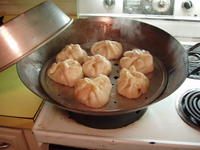Anyone Can Bake
What is a 'grandma' ? A grandma is old.
Math tells me that she was 57 the first time her youngest grandchild was laid in her arms but from my childlike perspective 50s, 60s, that was OLD. I know now that old doesn't mean much to a kid. Some years ago Helen presented her grandparents at her second grade show and tell. After an elegant introduction of 'this is Grandma and this is Grandpa' she opened the floor to discussion. One floor wriggling classmate immediately asked "How old are they?" Before my father could give his stock answer (old as dirt), Helen leaned to her peer and with unreserved diplomacy whispered to him "It's not polite to ask old people how old they are."
So what is my Grandma? Cheddar cheese gold fish. Crossword puzzles in ink. Undiluted and undivided attention. These are the things that made a lasting impression.
I only 'knew' my mother's mother during the last quarter of her life. She had already been formed/formed the place she would stand until the end of her life. That she had broken barriers to attain a college education, had a career, birthed and raised my mother, were peripheral. She was the person who opened the door so I could (easily) scoot under her arm on the way to the warm kitchen, to the toybox, to books, and a little engine that went huwuhooooooomph! when a thirty pound child sat on it; these were the important things.
With the confidence that only the most priveleged child can bear I once begged the gift of an old cookbook from her shelf, a household tome she had picked up decades earlier. This was a book that she had held if not dear, at least persistently from one age to another, and I remember my irritation as she actually hesitated before she passed it on to me. The fly leafs had her trained but distinctive looping handwritten recipes for 'Scotch Orange Marmalade' and 'Christmas Pudding.' Yet she granted it to me from my simplistic explanation that I wanted to practice 'how to set a table right.'
I'm picking up that cookbook, 'Anyone Can Bake' and a recipe cut from some forgotten newspaper falls out. There's no flag, no date. The recipe is for meat loaf made from pork, beef or lamb heart. It's offered with a menu rounded out with "scalloped potatoes, broccoli, and sliced tomato "from your Victory Garden." But what strikes me is the 'filler' blurb in the corner of the page. It reads--
"Save Tin Cans and You Save Lives.
Two tin cans furnish enough tin to make a syrette.' One syrette holds morphine to deaden pain 10 to 14 hours. Millions of syrettes are neeeded NOW. So keep on saving your tin cans."
I know what my Grandmother was and is to me. She made me the center of a universe. She loved me obviously, surreptitiously, brazenly, constantly. My daughter bears her name.
I am at a loss.
How can I conceive of who this grand woman was?






